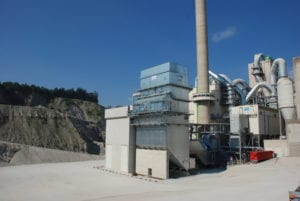
An example of a GEA fluegas-treatment plant for NOx emissions (Source: GEA)
GEA (Düsseldorf, Germany; www.gea.com) has received an order from thomas zement for a turnkey plant for the reduction of oxides of nitrogen (NOx) in fluegas. The order comprises two new reactors for selective catalytic reduction (SCR) including handling of the fluegas transport by induced draft (ID) fans and integration into the Erwitte production site. The contract also includes engineering services as well as the supply, installation and commissioning of steel structures, SCR catalysts, ID fans, heating circuits, duct connection and adaptation of NH3 injection from existing storage tanks. Production can continue during the installation of the SCR unit. Another very important advantage for the user: Only a short changeover time is required.
With this investment, thomas zement is supplementing the existing non-catalytic technology. After installation, this will create one of the most environmentally friendly cement production plants in Europe, says GEA..
Selective catalytic reduction (SCR) is a technique for the reduction of nitrogen oxides in exhaust gases from industrial plants. The chemical reaction at the SCR catalyst is selective. This means that the NOx are preferably reduced, while undesirable side reactions such as the oxidation of sulfur dioxide to sulfur trioxide are largely suppressed. SCR technology reduces NOx in the catalyst passing gas flow up to 95%. The core is the catalyst, which makes it possible to reduce the reaction temperature from around 1,000°C to a range of 230 to 400°C. High reduction rates can thus be achieved with a minimum of ammonia slip.
Due to an adequate low sulfur concentration and a sufficient temperature level, the SCR unit is installed low-dust behind the existing fabric filters. This arrangement has already proven itself in three successfully operated plants with the lowest NOx and NH3 emissions. Analyses of catalyst samples consistently show no loss of the high reactivity of the selected material and thus a long catalyst life.